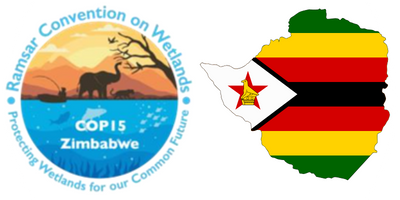Victoria Falls National Park

Victoria Falls National Park in north-western Zimbabwe protects the south and east bank of the Zambezi River in the area of the world-famous Victoria Falls. It extends along the Zambezi River from the larger Zambezi National Park about 6 km above the falls to about 12 km below the falls. A notable feature of the park is the rainforest which grows in the spray of the falls, including ferns, palms, liana vines, and a number of trees such as mahogany not seen elsewhere in the region. The park is located within the Zambezian and mopane woodlands ecoregion. Visitors have the chance to view the elephant, Cape buffalo, southern white rhinoceros, hippopotamus, giraffes, eland and a variety of other antelope herds during drives and walking safaris. A bask of crocodiles may be seen in the river, and a nearby Crocodile Ranch offers a safer view of these dangerous animals. Accommodations for tourists are provided in campsites in the Zambezi National Park and in the numerous resorts and hotels in and around the town of Victoria Falls which forms part of the western boundary of the park. This park is part of the 5 Nation Kavango – Zambezi Transfrontier Conservation Area (KAZA-TFCA).
Victoria Falls National Park
IUCN category II (national park)
Location Hwange District, ZimParks’ North-West Matabeleland Region, Matabeleland North Province, Zimbabwe
Nearest city Victoria Falls
Coordinates 17°55′S 25°40′E
Area 23.4 km2
Ramsar Wetland Designated 3 May 2013
Reference no. 2108
Ramsar Sites
Services & More
Wetlands are vital for human survival. They are among the world’s most productive environments; cradles of biological diversity that provide the water and productivity upon which countless species of plants and animals depend for survival.
Wetlands are indispensable for the countless benefits or “ecosystem services” that they provide humanity, ranging from freshwater supply, food and building materials, and biodiversity, to flood control, groundwater recharge, and climate change mitigation.
Yet study after study demonstrates that wetland area and quality continue to decline in most regions of the world. As a result, the ecosystem services that wetlands provide to people are compromised.
Managing wetlands is a global challenge and the Convention presently counts 172 countries as Contracting Parties, which recognize the value of having one international treaty dedicated to a single ecosystem.
The Convention uses a broad definition of wetlands. This includes all lakes and rivers, underground aquifers, swamps and marshes, wet grasslands, peatlands, oases, estuaries, deltas and tidal flats, mangroves and other coastal areas, coral reefs, and all human-made sites such as fish ponds, rice paddies, reservoirs and salt pans.
Zimbabwe's Vision 2030 aims to transform the country into a middle-income economy that is prosperous, inclusive, and sustainable. Central to this vision is the recognition of the importance of natural resources, including wetlands, in contributing to the nation’s socio-economic development and environmental health. Wetlands are vital ecosystems that support biodiversity, water security, climate resilience, and the livelihoods of communities.
As part of its commitment to sustainable development and environmental stewardship, Zimbabwe has incorporated the conservation and sustainable management of wetlands into its National Development Strategy 1 (NDS1), which covers the period from 2021 to 2025. The NDS1 serves as the country’s blueprint for achieving Vision 2030 and outlines key objectives, strategies, and actions to foster economic growth, environmental protection, and social well-being.
